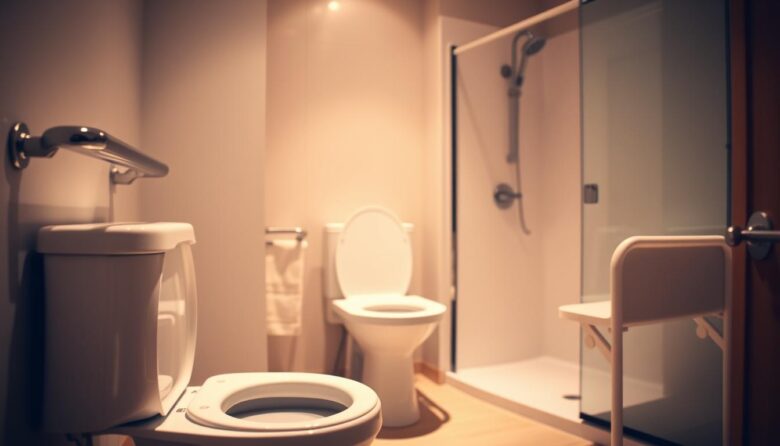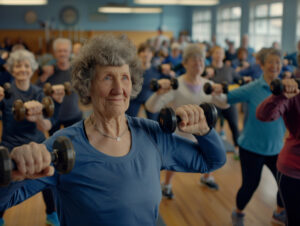Maintaining independence during restroom visits becomes increasingly challenging as we age. Over 25% of older adults face mobility limitations, with muscle weakness, joint stiffness, and balance concerns creating daily obstacles. These physical changes transform routine activities into potential hazards, particularly in spaces not designed for aging bodies.
Strategic modifications can dramatically reduce fall risks while preserving self-reliance. More than half of adults over 65 experience joint discomfort, and vision issues affect 1 in 4 people beyond age 70. These statistics highlight the urgent need for thoughtful bathroom adaptations that address multiple physical challenges simultaneously.
This guide examines practical solutions ranging from temporary support devices to permanent accessibility upgrades. We focus on evidence-based recommendations that balance security with personal autonomy. Our analysis includes product comparisons, installation tips, and real-world effectiveness data to simplify decision-making.
Properly implemented supports do more than prevent accidents – they restore confidence in daily routines. Whether addressing balance concerns affecting 33% of seniors or strength limitations impacting up to 50% of octogenarians, the right tools create safer environments without compromising comfort or style.
Understanding the Challenges in Elderly Bathroom Use
Navigating bathroom spaces safely becomes a critical concern as physical abilities change. Hard surfaces and confined layouts create risks amplified by common age-related conditions. Nearly 40% of older adults report difficulty performing basic bathroom tasks independently.
Physical Limitations and Sensory Changes
Muscle weakness affects 1 in 8 people over 60, complicating sitting/standing transitions. Joint stiffness impacts 53% of seniors, making precise movements near fixtures challenging. Balance issues contribute to 33% of annual falls occurring in bathrooms.
Visual impairments heighten these risks. 15% of adults over 75 struggle with depth perception in low-light conditions. This combination turns routine activities into potential emergencies without proper adaptations.
Identifying Critical Safety Needs
Effective solutions require understanding three core requirements: stable sitting positions, secure grip points, and clear visibility. Moisture-resistant flooring alone reduces slip incidents by 27% according to CDC data.
Proper lighting upgrades improve hazard detection by 40% for those with vision changes. Strategic placement of support structures helps maintain independence while addressing multiple risk factors simultaneously.
Fundamentals of Toilet Assistance for Elderly
Effective safety solutions begin with personalized evaluations of physical capabilities. Occupational therapists often assess strength, balance, and cognitive factors to recommend tailored support systems. This collaborative approach ensures modifications align with both current abilities and future requirements.
Defining Essential Supports in the Bathroom
Three primary categories address common challenges. Height-adjustable equipment reduces strain during transfers. Stability aids like rails offer secure gripping points. Non-slip surfaces and proper lighting complete the safety triad.
Selection requires understanding spatial constraints and personal routines. Narrow layouts might benefit from wall-mounted options, while larger spaces could accommodate freestanding supports. Professionals help families prioritize upgrades that deliver maximum impact.
Quality solutions maintain user autonomy through thoughtful design. Adjustable features allow gradual adaptation as physical needs change. Durable materials ensure long-term reliability without compromising bathroom aesthetics.
Regular reassessments keep support systems effective. Simple tweaks to aid placement or lighting intensity can address emerging challenges. This proactive approach sustains confidence during daily routines while minimizing accident risks.
Exploring Raised Toilet Seat Options
Standard bathroom fixtures often create unnecessary physical strain due to improper elevation. Raising seating surfaces by 2-5 inches significantly reduces joint stress during daily routines. This simple adjustment helps maintain independence while addressing common mobility challenges.
Standard Versus Portable Designs
Fixed models attach securely to existing fixtures using locking mechanisms, providing stable elevation without permanent renovations. These typically add 3-4 inches of height and suit long-term needs. Portable versions offer travel-friendly solutions with lightweight construction and tool-free setup.
Models with side arms combine elevation with transfer support. These benefit users requiring upper body assistance during position changes. Both types accommodate various weight capacities and bathroom layouts.
Implementation and Care Guidelines
Proper installation ensures stability and prevents shifting. Measure existing fixtures before purchasing to confirm compatibility. Most permanent models require periodic tightening of attachment hardware.
Clean surfaces weekly with non-abrasive products to maintain hygiene and material integrity. Check locking mechanisms monthly, replacing worn components promptly. Portable units need regular inspection for cracks or deformation.
Selecting appropriate elevation reduces muscle exertion by 40% during transfers according to recent ergonomic studies. The right choice depends on individual mobility levels, bathroom configuration, and lifestyle requirements.
Enhancing Safety with Grab Bars and Toilet Rails
Secure support systems transform bathroom safety by combining structural reinforcement with intuitive design. These critical infrastructure elements address transitional moments when balance matters most. Choosing between permanent and removable options depends on individual needs and environmental constraints.
Structural Support Versus Modular Solutions
Wall-mounted grab bars provide maximum stability through direct stud attachments. Their streamlined profiles blend with bathroom decor while offering 360-degree grip surfaces. Professional installation ensures compliance with safety standards requiring 30-50mm diameters and 60mm clearance from walls.
Freestanding toilet rails deliver immediate support without renovations. Adjustable clamps secure these units to existing fixtures, creating broad gripping surfaces. Though less permanent, they maintain stability during position changes for users needing flexible solutions.
Strategic Positioning for Optimal Safety
Horizontal placements at 33-36 inches above floor level assist sitting/standing motions. Vertical orientations near showers or entryways aid pulling maneuvers. Diagonal configurations help users with limited reach maintain balance during transfers.
Consult certified professionals to assess weight distribution and spatial limitations. Proper placement prevents overextension while ensuring immediate access during emergencies. Regular maintenance checks preserve structural integrity across all support types.
Improving Bathroom Lighting and Non-Slip Flooring
Environmental modifications play a critical role in preventing accidents where visibility and traction matter most. Over 15% of adults over 75 experience vision challenges that complicate navigation in dim spaces. Combined with slippery surfaces, these factors account for 38% of bathroom-related injuries annually.
Smart Illumination Solutions
Motion-sensor lighting activates automatically when entering the space, eliminating fumbling for switches. These systems provide 70-100 lumens of glare-free light – enough to identify hazards without disrupting sleep cycles. Night lights with light-sensitive triggers maintain gentle pathways to fixtures during midnight visits.
Traction-Focused Floor Upgrades
Rubber-backed mats with suction cups stay firmly anchored near showers and sinks. Textured vinyl flooring reduces slip risks by 52% compared to standard tiles according to CDC research. Look for materials with R10 slip ratings that balance safety with easy cleaning.
Combining these upgrades creates layered protection against common hazards. Properly placed lighting reveals wet spots while grippy surfaces prevent dangerous slides. Together, they address 80% of environmental risk factors linked to bathroom accidents.
Integrating Mobility Aids for Safe Sitting and Standing
Strategic use of mobility tools enhances safety during essential daily routines. These devices bridge the gap between full independence and requiring help, offering stability during critical movements. Proper selection and placement can reduce fall risks by 42% during transfers according to recent ergonomic studies.
Matching Aid Features to User Needs
Walkers provide bilateral support with their four-legged design, ideal for those needing maximum stability. Positioned near fixtures, they create secure anchor points for controlled sitting motions. Wider bases accommodate varying reach distances while preventing tipping.
Rollators combine mobility with maneuverability through wheeled frames. Their compact profiles suit smaller spaces, allowing easy repositioning without lifting. Locking brakes ensure stationary support during transitions.
Uplift canes feature ergonomic handles that amplify leverage during standing movements. Angled grips reduce wrist strain while transferring weight smoothly. These specialized tools prove valuable for individuals managing moderate strength limitations.
Space constraints and physical capabilities dictate ideal choices. Occupational therapists recommend trial periods with different models to assess comfort and effectiveness. Proper training ensures users leverage aids safely while maintaining confidence in daily routines.
Accessory Solutions for a Safer Bathroom Environment
Practical enhancements can transform bathroom safety through smart accessory choices. Affordable modifications address hygiene challenges while preserving independence during personal care routines.
Innovative Hygiene Systems
Installing bidet seats eliminates twisting motions during cleaning. Touch-free operation reduces infection risks while providing gentle water streams for sensitive skin. These systems prove particularly valuable for users managing arthritis or limited reach.
Extended Reach Tools
Long-handled aids empower users to maintain cleanliness without straining. Angled grips and lightweight materials enable secure handling during delicate maneuvers. Properly designed tools reduce reliance on caregivers by 38% according to recent studies.
Strategic Storage Solutions
Relocating essential items minimizes dangerous reaching. Position toilet paper holders within arm’s reach and install front-facing shelves for daily necessities. These adjustments prevent balance disruptions while keeping supplies accessible.
Thoughtful accessory selection creates layered protection against common hazards. From adjustable cleaning systems to ergonomic storage layouts, these upgrades deliver professional-grade safety through consumer-friendly installations.



